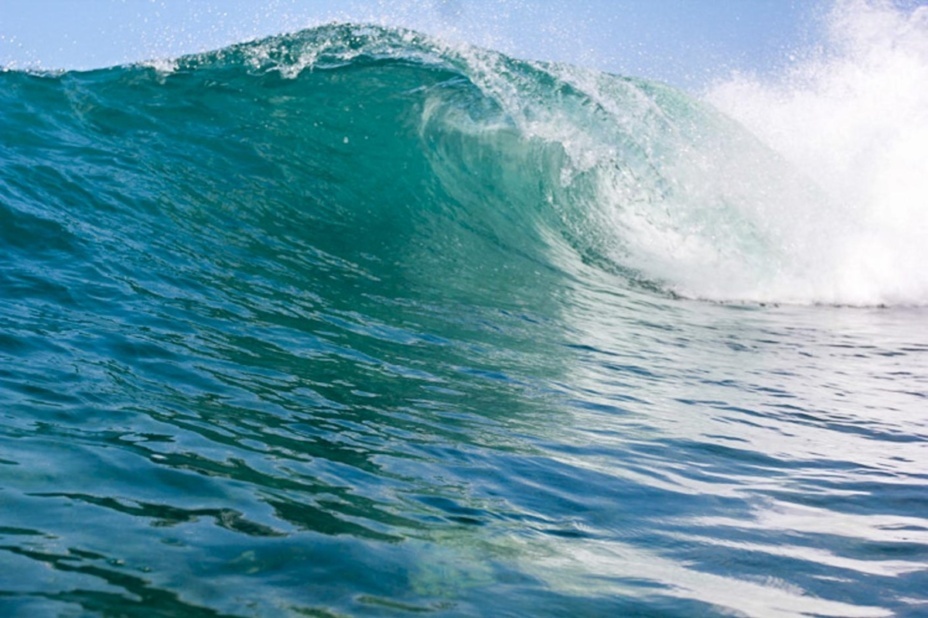
Surfing milestones
From white water to barrels, airs & co.
Anyone who starts surfing this days has the opportunity, thanks to the Internet and all sorts of other media, to get smart in advance about what to expect when surfing. Therefore, almost everyone knows before the first surfing lesson that initially, armed with a softboard, you spend a few hours in the white water to learn the basics. One thing is certain: there are at least 10 reasons to learn to surf!
Surfing has become more and more popular over the years and surfing sells! Nowadays you can follow every surf contest worldwide from your laptop – completely uncomplicated in your own apartment, far away from the nearest surfable ocean. So today, practically everyone knows what the pros are like, which boards the guys and gals are surfing and which places you absolutely have to see in the course of your surfing career.
But what happens between the first surfing attempts in white water and the professional career? Once you’ve got the basics down, should you switch straight to a hardboard or even a shortboard? Reef or beach break – which spot is best for which surf level?
To help you answer these questions, we have divided the different surfing goals into milestones in this blog. In addition, you can find out which spots in the south of Sri Lanka – the home of the drivethru surf camps – and which boards are best suited for your respective learning goal.
Milestone 1 – the takeoff in white water
Goal:
At the beginning of your surfing career you learn to stand up in white water and surf standing up to the beach with the wave already broken. After some time you will already learn to ride easy turns.
Especially important: Already at the beginning it is absolutely necessary that you acquire a good knowledge about board handling and safety in and out of the water. The coarse and fine trim (the position of the surfer on the board and the control of the surfboard) and the different diving techniques should be learned right at the beginning. This is the only way to keep control of your own board and thus protect yourself and other surfers from unnecessary injuries.
Therefore, good surf schools and camps always teach these contents already in the beginner course and refresh them later if necessary.
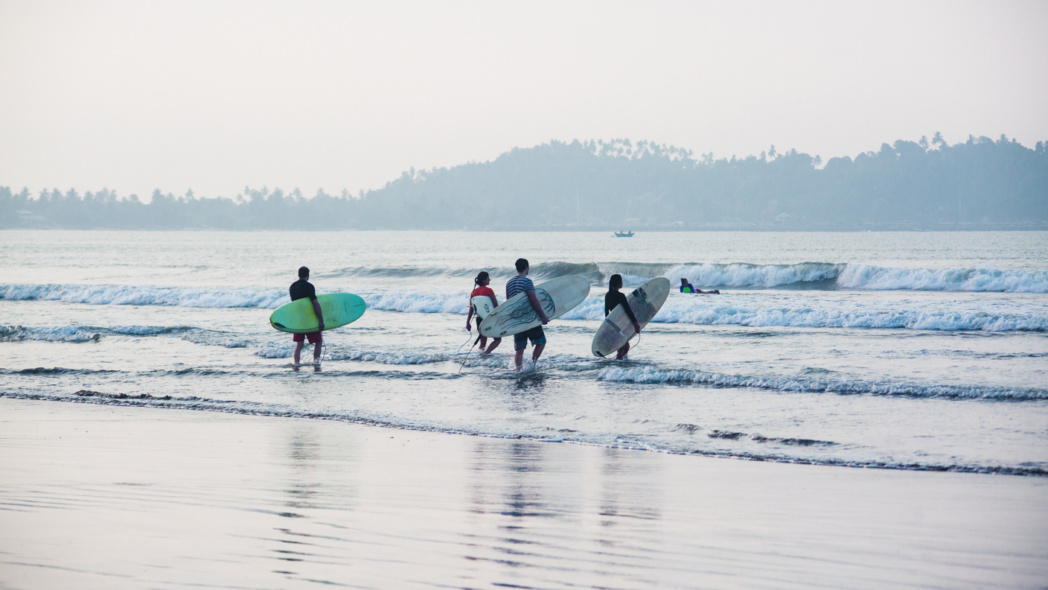
Board selection:
The right choice here are softboards in a length of 7’0 and 9’0 feet (1 foot = 30.48cm). The right board length here always depends on a person’s own height and body weight, as well as their individual fitness level. Softboards are ideal at the beginning in any case, because they have a considerable volume and a large sliding surface in the water. Advantages here: They provide a stable base, thus forgiving many mistakes and, due to their soft nature, ensure that the risk of injury in the event of a collision between man and board is low.
Spot selection:
The best white water waves on the south coast of Sri Lanka can definitely be found at Matara beach and Weligama bay. At this time reefs are not the suitable spots at all. The risk of injury by touching the sharp corals is simply too high. At the beach breaks you don’t have to worry about corals and can fully concentrate on practicing the basics!
Milestone 2 – the green wave launch
Goal:
Once you have completed the first milestone, you will continue with the so-called green wave start. This means that you learn how to get a still unbroken (green) wave and then ride it down towards the beach. To master this task you need additional knowledge about right of way and rules of conduct as well as how to position yourself in the line up to the wave. The best way to get the “right eye for good waves” is to spend as much time as possible in the water.
Also, even at this level, you can’t help but continue to perfect fine trim and plunge techniques to reach your goal.
Board selection:
Even when learning the green wave launch, you should continue to use a softboard between 7’0 and 9’0 feet (1 foot = 30.48cm). The softboard helps you get the wave long before it breaks and gives you much more time than a hardboard to perceive the different phases of the green wave launch and perfect them in the next step.
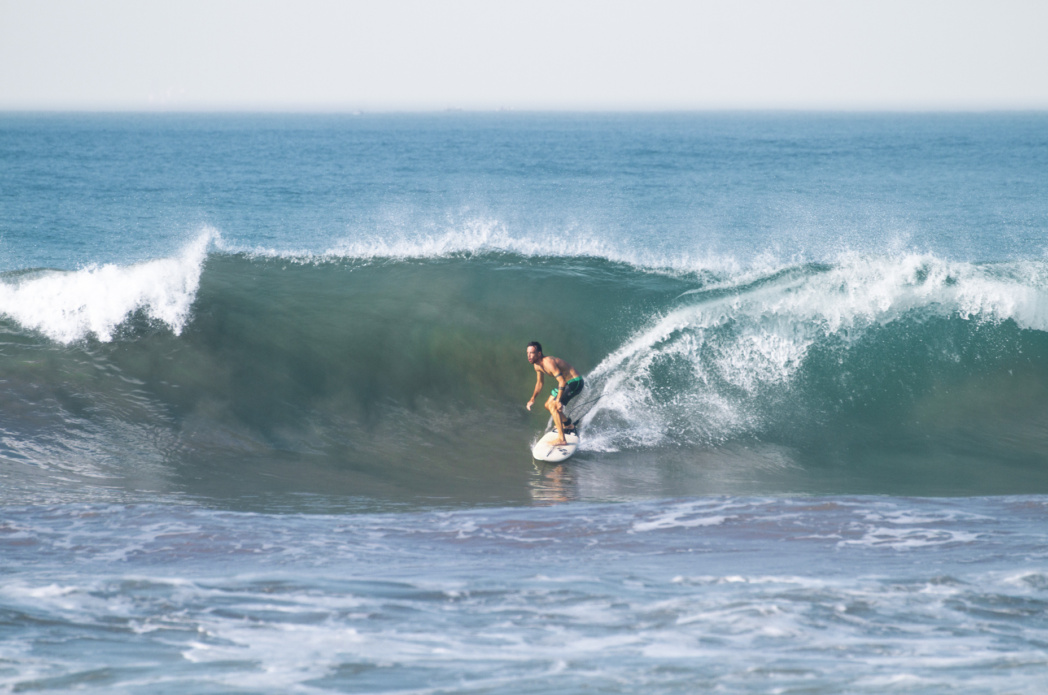
Spot selection:
The best spot in Sri Lanka to learn this step is the beach break of Weligama as well as another spot we don’t want to tell you about yet…
You will realize very quickly that respecting the rules of the right of way in the water now also demands a lot from you. Especially in the beginning you are often “with blinders on” in the water. What does the wave do? Glide phase! Support! There are simply so many things you have to think about at the same time. This is completely normal, especially in the beginning. So that you can concentrate on your task as best as possible now, here’s the premise: Rather train on a wave that may not break perfectly in one direction, instead of going to the best wave on the beach where many other surfers are crowded. As I said, your goal is to first get a perfectly timed green wave start and ride the wave straight towards the beach – before continuing with the parallel ride in the next step.
Milestone 3 – The parallel journey
Goal:
Do you master the timing of the green wave start? The glide into the wave is no longer an indefinable feeling for you, but rather a consciously executed and controllable technique? Then the next step is to learn how to ride parallel! Your goal is to steer the board into the direction of the wave during the gliding phase, i.e. before the take-off. Because only with this technique you can determine the angle of entry into the wave yourself and surf faster and hollow breaking waves in the future.
A good wave selection, the right positioning to the wave as well as the ability to recognize in which direction a wave breaks are, among other things, prerequisites for successful parallel riding.
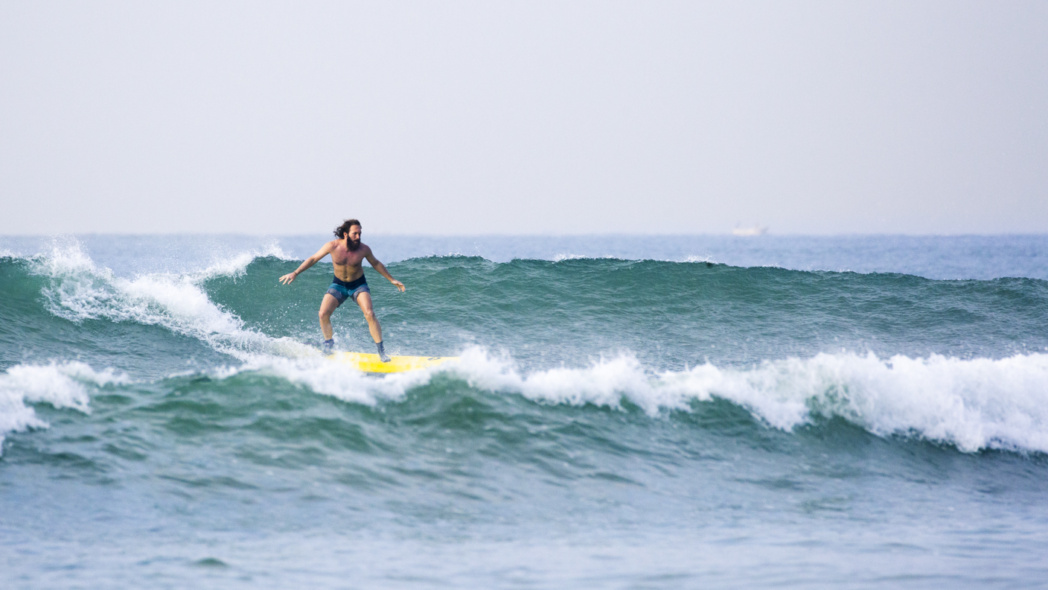
Board selection:
To give you a very early and long glide phase in the wave and to give your body the chance to automate the movement of turning in, a softboard between 7’0 and 9’0 feet (1 foot = 30.48cm) is also the right choice here! Depending on your own fitness level, you can now choose the length of the board a bit smaller than in the steps before. Smaller boards are a little easier to turn than longer boards. However, this step is only recommended if you no longer have problems getting into the glide phase early. Just be honest with yourself here and evaluate neutrally. You won’t do yourself any favors by changing boards too early!
Spot selection:
The spot selection is a bit tricky here! On the one hand, you need waves that break in one direction, whether to the left or right. On the other hand, it’s advantageous to practice this move with as few other surfers in the water as possible. Because even now you are still a lot focused on yourself and your practice.
You can find these waves on Sri Lanka’s south coast at the beach breaks of Meddawatta (Black Sands) and Weligama. Reefs would indeed make it easier for you to find the point where the wave starts to break and to recognize in which direction the wave breaks (the wave direction is often earlier and easier to recognize at reef breaks). However, surfers with more experience usually surf the reefs. This can mean that you end up being more busy dodging or watching the other surfers than surfing waves yourself. Top priority: catch as many waves as possible to automate the movements! Again, rather than surfing the very best wave of the spot, look for a wave with fewer surfers on it!
Milestone 4 – Generating speed
Goal:
Wonderful! The parallel ride works and you are now ready to “get more out of the wave”. Speed is the key to mastering different turns later on. To generate more speed, it is especially important to load the board properly while standing up, i.e. to trim. With well-timed compression and stretching phases of your body, you learn to first ride the wave in sine curves on a rail (edge of the surfboard). Later on you will also learn to change rails. Once you have mastered this, you continue with speed pumps in the upper third of the wave to generate even more speed.
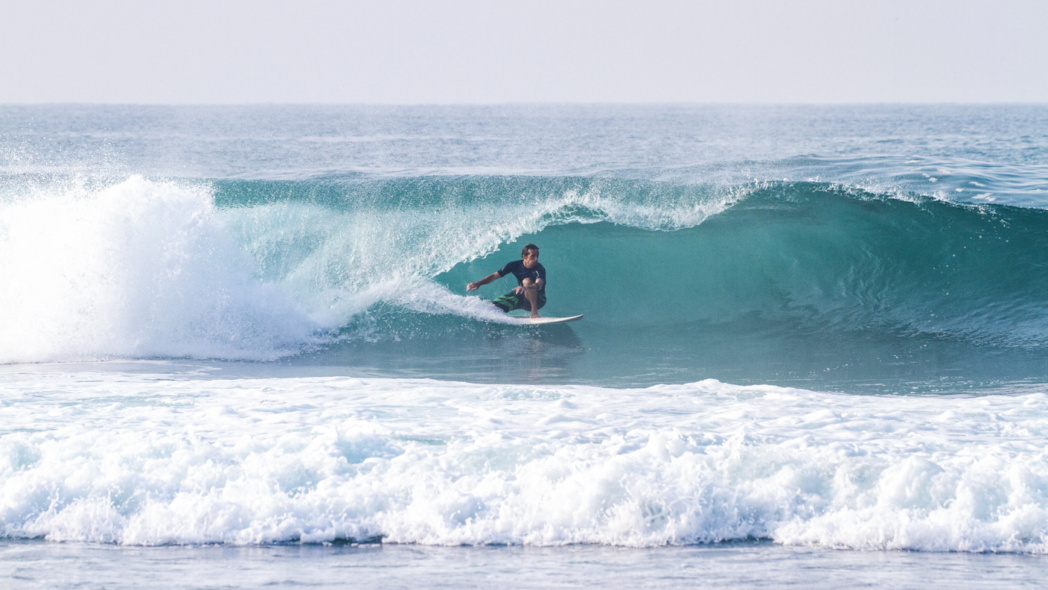
Board selection:
The time has come: For the first time in your surfing career you have advantages by switching to a hardboard. The prerequisite, however, is that you don’t have any difficulties getting into the glide early with the hardboard in pretty much any wave and that it’s easy for you to get into the parallel ride in a controlled manner. If this is not the case, there is absolutely nothing to be said against simply continuing to surf a softboard. The disadvantages of softboards only come into play during really aggressive turns, when the somewhat softer fins in the softboard can no longer counteract the pressure of the wave, and you simply “smear”. The big advantage of a hardboard is that it is much more responsive. A characteristic that was its biggest disadvantage when learning the steps before. Your best choice in terms of board shape and size is now a “minimalibu” between 7’0 and 8’0 feet (1 foot = 30.48cm), always depending on your height and weight.

Spot selection:
You can obey the right of way rules, avoid other surfers early and in the right direction, have your board under control and no problem getting waves at spots where there are several surfers in the water? Then head to the nearby reefs of Madiha, Polhena and Co! But that doesn’t mean that the beachbreaks in the area are not suitable anymore. You just increased your spot selection in the end. Yay!
Milestone 5 – The Basic Maneuvers
Goal:
Once you have learned to build up speed, it is now important to maintain it. First and foremost, maneuvers are there to make the best use of the different sections of a wave. Different types of waves or wave sections require different maneuvers to maintain or re-generate speed. Basic maneuvers to learn first include bottom turn, re-entry, snap, cutback and floater.

Board selection:
To learn the maneuvers in the basic form, it is useful to continue surfing a minimalibu. Due to its size (large sliding surface, a lot of volume), it generates a high inherent speed and smoothness. Both help you to concentrate completely on the new technique requirements.
Once the base is established, you now have the full range of surfboards at your disposal. It will take you a while to figure out which board type suits you best. Whether it’s a shortboard, fish, minimalibu or longboard, pretty much anything is possible with any board. Always keep an open mind and be willing to experiment!
Spot selection:
Depending on the wave conditions you can now surf all reef and beach breaks of Sri Lanka.
Other milestones: More spray, barrels and airs and co.
The beauty of surfing is that there are simply no limits upwards. There is always something to learn, improve or just enjoy. That is then simply a matter of type!
Examples of other milestones:
- Speed, Power & Flow: Generated by the ideal combination of various maneuvers
- Countless variations of the basic maneuvers
- Dancing surfing on longboards
- More spray in the turns
- Riding Barrels
- Jumping Airs
- Big Wave Surfing …
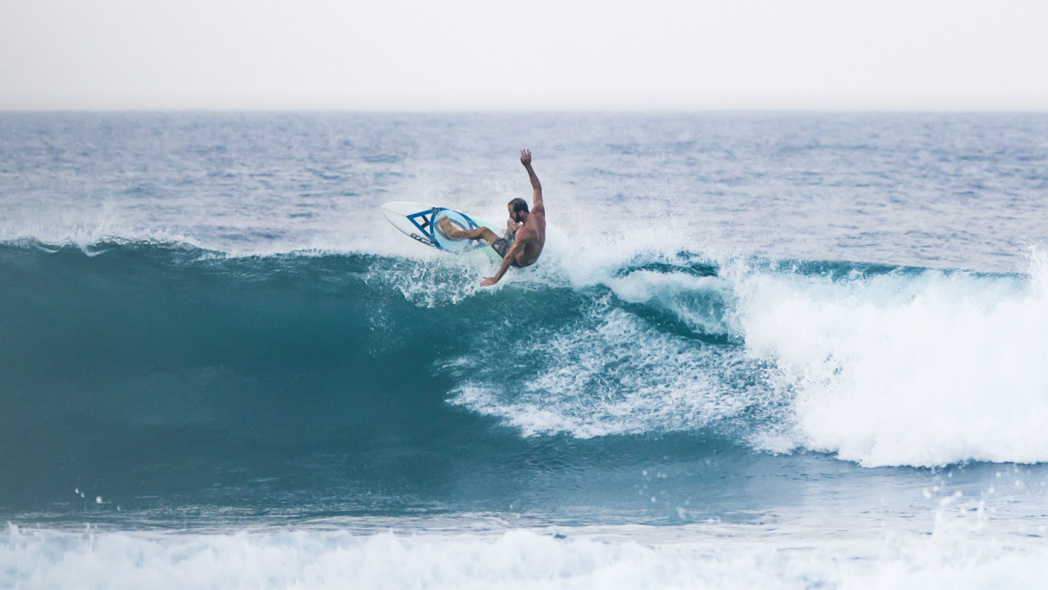
Milestones are like dominoes
Surfing is one of the most difficult sports to learn. The constantly changing conditions in the ocean are of very great importance. It takes a lot of time and patience to get to the appropriate number of repetitions needed to learn and internalize new movements. Nevertheless, anyone can learn to surf with the right guidance.
The described milestones should help you to get an overview in which order you should concentrate on which tasks. This way you will make the fastest progress and learn the different levels of surfing at the right time. The right equipment and the right spot selection play an equally important role.
The most common and serious mistakes you can make when learning to surf are called impatience and overestimating yourself. The media floods us with pictures and surf clips that make surfing look very easy. However, one must not forget that most of the surfers depicted are professionals and have spent a lot (!) of their lives in the water and continue to do so every day. This is the only way it is even possible to reach such a professional level.
Many also underestimate how important it is to have an experienced and neutral surf instructor at your side, who can objectively assess your individual skill level and learning progress and set the right tasks at the right time. Of course, this doesn’t mean that you have to spend the next years only in surf schools and surf camps to become a good surfer. But it is advisable to get feedback from time to time, e.g. in the form of a surf course or coaching, to check whether you are still on the right track or whether a few essential basics were perhaps left out at a certain point.
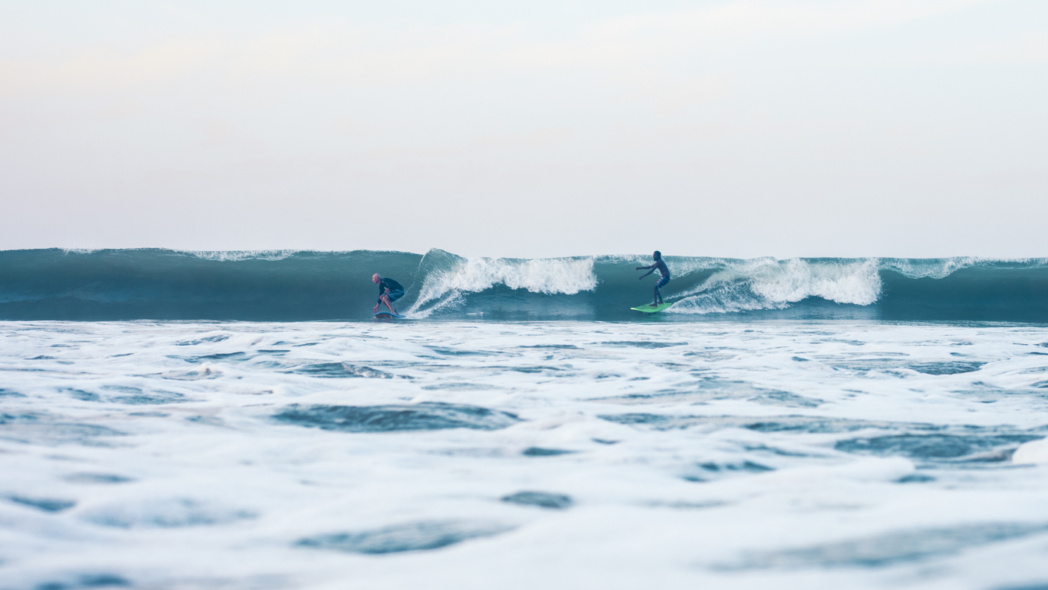
To better visualize this, just imagine that each of these milestones is a domino. Once you have perfected all the tasks and phases of the first milestone, you get to set up the first domino. Now you move on to milestone number two, the green wave start. You have also perfected this and you place another domino. You continue to work your way forward and eventually have a row of dominoes lined up. All the dominoes are lined up perfectly so that whenever you nudge the first domino, the next domino is hit and eventually the entire row falls.
Example: Right now you’re working on practicing your first Basic maneuvers. Because you’ve done a good preliminary job, the individual stones are gradually falling against each other and one after the other. This means for your surfing: If you surf ten waves and have previously learned and perfected all the milestones in the correct order (controlled start into the wave, speed build-up, correct section selection in the wave), you will also get to reach the next milestone “turn” in all ten waves.
The situation is different if you have not practiced a milestone to perfection. You completed milestones one and two excellently, but for milestone three you didn’t have the patience to practice turning in the glide long enough. Milestone number four didn’t interest you at all. So now you practice one turn after another, falling all the time and worrying about what you have to do differently in that turn to finally make it work. The problem is not the technique of the turn, but what went wrong before. You never learned to determine the angle of entry into the wave and to build up speed. But these are the basic requirements to be able to ride turns.
Every now and then, by chance, it works out anyway. Which keeps you from taking a step back and tweaking the basics again. Nevertheless, in this way you have formed a row of dominoes in which domino number three and four are slightly offset. By chance, the dominoes also fall over sometimes in two out of ten attempts. Problem here: In eight cases it does not work. In this way, you quickly waste several years with little progress and a lot of frustration. An experienced view from outside can often be the key to success!